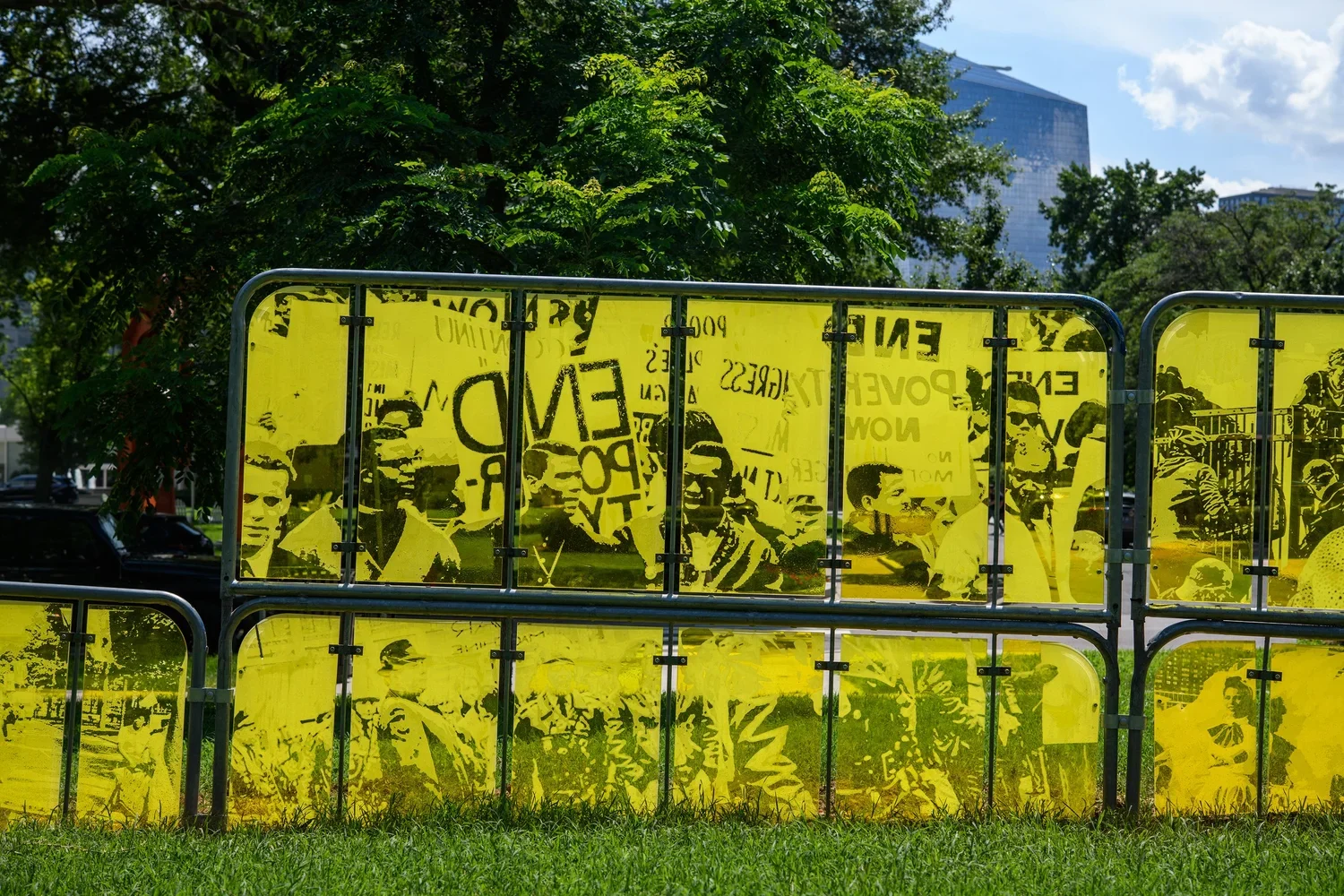Review: Nicolo Gentile’s Bar None Celebrates the Right to Assemble
by Jeff Joseph Katz
Arts Committee Member Jeff Joseph Katz reviews Nicolo Gentile’s Bar None, a public sculpture by the Association for Public Art on the Benjamin Franklin Parkway.
image: a detail of the metal barricades of Nicolo Gentile’s sculpture Bar None with images etched in yellow acrylic panes emerging through the lawn. In the uppermost image, protestors hold signs that read “End Poverty,” with the text reversed. Image sourced from Gentile’s website at nicologentile.com/bar-none
As it happens, the day I chose to visit Nicolo Gentile’s new public sculpture Bar None was perhaps the ideal day. The Puerto Rican Day Parade flooded the Benjamin Franklin Parkway: celebrants in reed pava hats passed bewildered tourists, cops loitered near socialist organizers, and companies dispensed free samples to passersby grooving to Spanish-language pop music. From afar, a streak of highlighter yellow glimmered across the grass of Maja Park. As I exited the throng and approached what felt (comparatively) like a quiet glade, the sculpture revealed itself: steel barricades half-embedded in the ground, framing panels of acrylic etched with archival photos. Each image is a historical snapshot of the very Parkway it now occupies, from pride parades to protests, athletic events to civic demonstrations, spanning from the early 1900s to the present.
Bar None is the second commissioned work for the Association for Public Art’s “Art on the Parkway” initiative, an annual juried commission aimed at activating the Benjamin Franklin Parkway. Gentile’s piece draws from his research alongside archivists at the Free Library, the Temple University Special Collections Library, UPenn’s University Archives, the William Way LGBT Community Center’s John J. Wilcox, Jr. Archives, among others. The etched images have been simplified for legibility, preserving the figures’ gazes, their sense of life, the urgency of their gestures in moments of celebration, recognition, and protest.
The installation runs parallel to a walkway, but a break in the barricades invites viewers to approach and pass through the barrier to a grove of trees. As I walk off the concrete path onto the grass, I can see how the translucent acrylic glazes the lawn with color, the way stained glass coats a congregation with stretched images of saints: the past superimposed over the present. Bar None’s imagery is etched in such a way that the parts of the images that were originally the darkest are now the most transparent, making the shadows on figures’ faces windows to soft grass or sizzling asphalt.
image: studio portrait of Nicolo Gentile
While this is his first public art commission, it’s hardly Gentile’s first artistic foray into the topic of public memory. A graduate of Tyler School of Art and Architecture (and current Adjunct Professor there), his works prompt complex encounters with the past through objects layered with grief, wit, and eroticism. Evoking the likes of David Wojnarowicz and Félix González-Torres, Gentile’s work deliberately centers acts of commemoration, especially of covert queer desire in public masculine spaces (one might argue the Ben Franklin Parkway falls into this category). His recent series Hold on Me and Vice Grip both feature cast aluminum handprints fused to workout equipment, conjuring phantom sense-memories of a demolished cruising gym on 12th street. Gentile’s understanding of the body’s ability to hold memory makes his choice to utilize steel barricades in Bar None – those objects that control the movement of bodies, that are gripped, pressed against, even overturned in moments of passionate transgression – especially potent.
On September 18th, Gentile gave an artist talk at the Parkway Central Library, where he asserted the need for public art to “stir up” the past, transforming it from a frozen image into an ongoing act of remembrance, situated in physical space. Gentile was supported by a presentation of archival footage by John Pettit, Associate Archivist at Temple University Library’s Special Collections Research Center. The footage provided glimpses of the past through news footage and amateur videography, from previous public art installations to Bicentennial celebrations to Cold War civil defense drills. The footage contextualized Bar None, where diverse causes, energies, and demographics converge across time to symbolically gather once again on the Parkway in what Gentile calls “a tribute to the act of gathering itself.”
image: Photo by Constance Mensh for the Association for Public Art
It had rained the night before I came to Maja Park, and the moisture that had seeped between the sandwiched layers of acrylic struggled to escape even as noon approached. Foggy droplets of water suspended within the plastic sheets appeared like sweat on the skin of protestors, a visible discomfort of showing up. Across the parkway, salsa music mingles with truck horns and the whooping of sirens.
Under the current administration, crackdowns on political activism continue to escalate, especially surrounding the racial justice and pro-Palestine movements. At a moment when the digital can feel more real than the physical, Bar None asserts the irreplaceable nature of in-person gatherings. As the clouds of fascism affirm the need for and threaten the future of political assembly, Bar None asks: when else have we felt this way? How did we respond?
The installation will remain up through October. In connection with Bar None, the Association for Public Art will hold a public workshop Assemblage: Exploring Social Change through Collage on October 4th at 2pm at the Parkway Central Library, in collaboration with Collage Philadelphia.
Featured in the Issue 15: October, 2025 edition of WayOut, your Philly Queer Arts Publication brought to you by the Arts Committee at the William Way LGBT Community Center. To get our monthly newsletter in your inbox, subscribe here.



